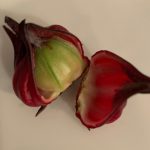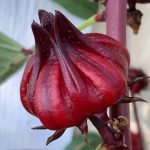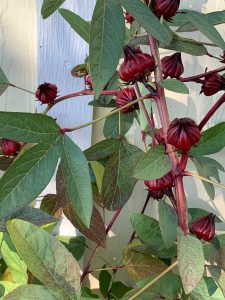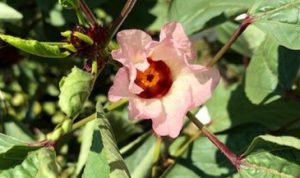Just before the recent cold weather I harvested seed pods from my roselle, Hibiscus sabdariffa, and made the most delicious and nutritious iced herbal tea.
You may have heard other names for this plant of Asian or African origin: bissap, red sorrel, Indian sorrel, Jamaica sorrel, Florida cranberry or jelly okra. Whatever name you call it, it has been grown in Florida since the late 1890’s.
People around the world enjoy consuming roselle in many ways. In addition to making a beverage from the fleshy fruit, it is used to make jams, jellies, relishes, syrup and added to salads. Harvest the fruit when it is large (as in the photo) but before it gets tough. Leaves can be eaten raw in salads or cooked into dishes. Even the seeds can be made into a high protein meal or ground into a coffee substitute.

Roselle fruit showing the unripe green seedpod surrounded by the fleshy calyx. Photo credit: Mary Salinas, UF/IFAS Extension.
My lone roselle plant provided hundreds of fruits and was so easy to grow. In the spring it started as a small 3-inch seedling and by November it grew to over 4 feet tall and wide. Roselle can grow 6 to 7 feet tall. It’s not too picky on soil type if it gets plenty of sun and consistent moisture. Few pests are attracted to roselle. However, deer will eat this down to the ground, as they will any hibiscus. Since my garden is plagued by hungry deer, I placed the roselle in the back of a landscape bed with a border of plants unappetizing to the deer. Expect roselle to start blooming in mid-summer and continue through frost. Blooms only last one day before forming the equally attractive fruit.
Roselle is a tropical plant and susceptible to frost in northwest Florida. To have seeds for next year, let some of the fruit stay on the branches to let the seed pods turn yellow/brown and ripen. There are also many online seed companies that carry seed.
For more information:
UF IFAS Gardening Solutions: Roselle
More on Roselle from Purdue Extension
- Sugar Belle Mandarin: A Great Choice for the Florida Panhandle - November 22, 2021
- LandscapeQ & A - August 20, 2021
- Let’s Talk Beneficial Insects - August 18, 2021



